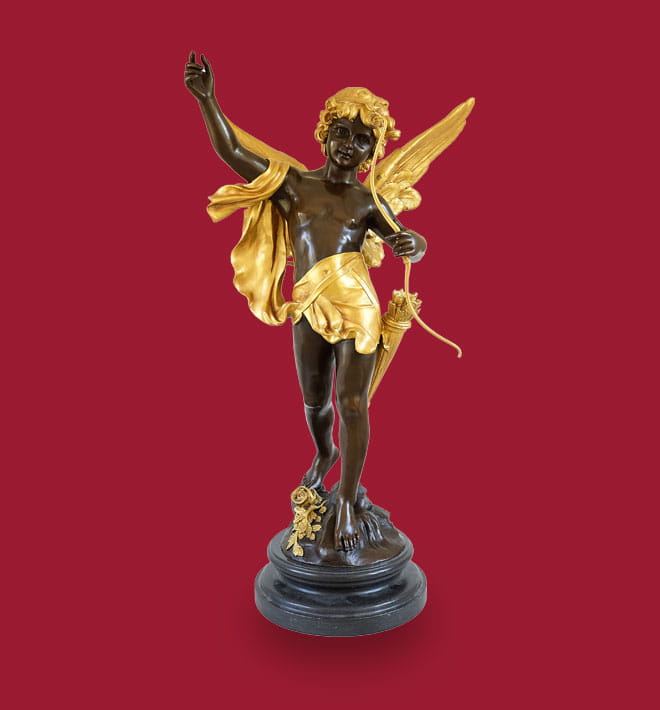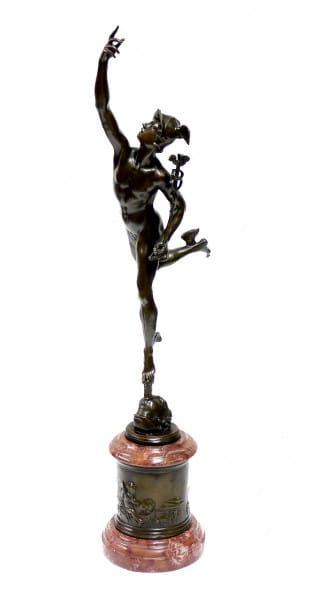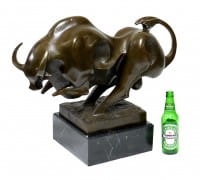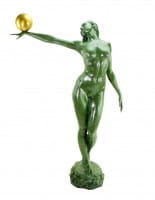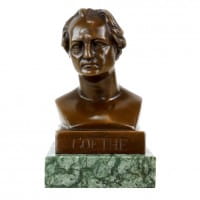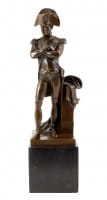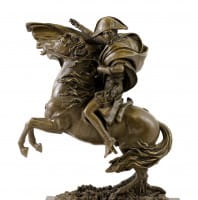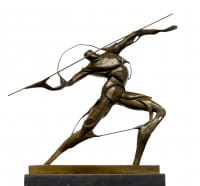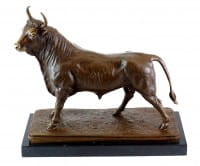Prices incl. VAT, free shipping worldwide
Ready to ship today,
Delivery time appr. 3-6 workdays










Product description
"Messenger of the gods mercury - Statue of Hermes "
| Weight | 9,8 kg |
The Flying Mercury – A Bronze Masterpiece - Signed Giambologna
This magnificent Statue of Hermes, also known as The Flying Mercury, is one of the most iconic depictions of movement and grace in the history of sculpture. The god is portrayed in the very moment of ascent, his body perfectly balanced on one foot as he rises toward the heavens. His extended arm and poised fingers point upward, symbolizing divine communication and celestial purpose. Every muscle and gesture radiate lightness, as though the bronze itself defies gravity. The result is an extraordinary image of vitality and elegance, a symbol of intellect in motion that embodies the spirit of the Messenger of the Gods Mercury.
The Life and Vision of Giambologna
The creator of this masterpiece, Giovanni da Bologna (born Jean de Boulogne in Douai, Flanders, in 1529), was a visionary sculptor of the Florentine School, active during the transition between Mannerism and the early Baroque. He received his initial training in Antwerp before traveling to Italy, where his talent soon captured the attention of the Medici family. Giambologna’s education combined the precision of northern craftsmanship with the expressive power of Italian design. Working in Florence until his death in 1608, he became one of the most celebrated sculptors of his time, producing dynamic bronzes and monumental marble works that redefined the concept of sculptural movement. His Statue of Hermes remains among his most admired creations, a synthesis of technical mastery and poetic imagination.
The Birth of the Flying Mercury
The original Flying Mercury was created in Florence around 1580 for the Medici court, representing the epitome of Giambologna’s fascination with grace and balance. In this composition, the god hovers on the breath of Zephyr, his winged sandals and helmet carrying him aloft. The caduceus — the staff entwined with serpents — rests gently in his hand, signifying his role as messenger and guide. The sculpture’s fluid lines, twisting torso, and airborne dynamism make it an enduring symbol of harmony and proportion. Every aspect of this Hermes Statue Greece evokes divine energy and human aspiration, uniting the mythological and the physical in a single, breathtaking gesture.
The Symbolism of Hermes and Mercury
Hermes, or Mercury to the Romans, was the swift and clever Messenger of the Gods Mercury, the protector of travelers, merchants, and poets. This Statue of Hermes captures him at the moment of flight, connecting heaven and earth through motion. The raised arm symbolizes enlightenment and communication, while the forward gaze suggests focus and intelligence. His youthful, athletic form embodies vitality and freedom, reminding viewers that wisdom often travels hand in hand with speed. As the patron of eloquence and ingenuity, Hermes became the perfect subject for Giambologna, whose own genius lay in translating movement into bronze. This Hermes Statue Greece thus speaks not only of mythology but of the eternal human desire to transcend limitation.
Craftsmanship and Bronze Perfection
The technical brilliance of Giambologna’s Statue of Hermes lies in its balance between physical tension and visual lightness. Cast using the lost-wax technique, the bronze surface reveals exquisite anatomical detail — each tendon, vein, and muscle modeled with lifelike precision. The polished patina catches the light in a way that enhances the illusion of motion, while the sculptural composition achieves an almost impossible equilibrium on a single point of support. The fine red marble base, often used in versions of this Hermes Statue Greece, complements the brilliance of the bronze and anchors the god’s ethereal flight in material stability. Giambologna’s skill allowed him to transform weight into elegance, metal into pure energy.
Influence and Enduring Legacy
Giambologna’s Flying Mercury became one of the most influential bronzes of the Renaissance and remains a highlight of European collections today. Original and later casts of the Statue of Hermes can be admired in the Museo Nazionale del Bargello in Florence, the Louvre in Paris, and the Victoria and Albert Museum in London. For centuries, the sculpture has symbolized the triumph of intellect and beauty, inspiring countless artists and collectors across Europe. As one gazes upon this Messenger of the Gods Mercury, one feels both the divine and human dimensions of creation — the soaring spirit of invention embodied in eternal form.
Eternal Grace in Motion
This masterful bronze Statue of Hermes, signed by Giambologna, captures the god’s boundless energy and celestial poise with unparalleled refinement. It unites myth and movement, intellect and craftsmanship, in one harmonious vision of divine ascent. The god of swiftness, communication, and transformation hovers eternally above the earth, symbolizing the human pursuit of knowledge and transcendence. The Messenger of the Gods Mercury continues to remind us that true greatness lies in grace, balance, and the eternal flight of the spirit.
Height: 90 cm
Width: 38 cm
Depth: 22 cm
Weight: 9.8 kg
100% Bronze
Our advantages
free shipping
Worldwide free shipping
14 days money back
You can cancel your order
within 14 days
secure payment services
Paypal, Master Card, Visa, American Express and more

